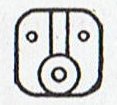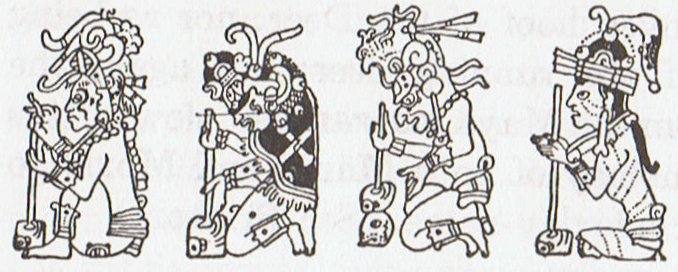We surely must continue and make a stop at Tau-ono. But we also need to tread carefully and look (ira) at the full text.
| Ira 1. Then, there, behold; o ira, no ira, so, wherefore, from that time; ki te ira, yet, already. 2. To turn around to look; hakaira, id. 2. Pau.: ira, skin disease. Mgv.: ira, dark patches on the skin. Ta.: ira, skin disease. Mq.: iá, birthmark. Sa.: ila, id. Ma.: ira, a freckle. 3. Mgv.: iramutu, nephew or niece. Mq.: iamutu, son or daughter of a man's sister. Sa.: ilamutu, cousinship of children of brother and sister. Ma.: iramutu, nephew, niece. Churchill. |
I decided to eliminate the nakshatra dates as incompatible with the heliacal dates. It should be enough to keep track of the nakshatra stars (and the lunar stations):
| 'Februarius 21 |
22 (51) |
23 (Terminalia) |
| no glyph |
 |
 |
| Ca1-1 |
Ca1-2 |
| koia |
ki te hoea |
| Al Fargh al Thāni-25 / Uttara Bhādrapadā-27 / Wall-14 |
χ Pegasi (340.4), θ Andromedae (341.0) |
| Caph, SIRRAH (338.8), ε Phoenicis (339.1) |
ALGENIB PEGASI (340.0) |
| Alchita, Ma Wei (156.1), Minkar (156.7), ρ Centauri (156.9) |
Pálida (157.6), Megrez (157.9) |
Hasta-13 / Chariot-28 |
| GIENAH (158.1), ε Muscae (158.2), ζ Crucis (158.4), Zaniah (158.9) |
The 13th Hindu station was Hasta, which could have been alluded to in the shape of the tara glyph Ca1-2.
 |
 |
| tara |
tara hoea |
Raven had his 'fist' (nothing as yet counted) at September 22 but half a year later his 'claw' was empty:
| CORVUS: |
| 13 |
Hasta |
α, β, γ, δ, ε Corvi |
Hand or fist |
185 = 178 + 7 |
| the hand |
Gienah (?) |
Sept 22 (265) |
Terminalia was where the Raven half of the year was 'grasped' by the hand in the west (Mayan Chikin):
| ... The open right hand of Blood Moon receives the 'spittle' of the 'coco'. This 'hand' we can name Chikin, because in Maya-land that is the name for the direction west (where all sky persons will descend, fall on their faces).
The horizon in the west is where Sun disappears in late afternoon. In the morning when Sun reappears in the east he is like a newborn baby, at noon he is standing tall, and in the afternoon he shrinks - he is growing old. His disappearance in the west was called 'the biting of the sun' (Chikin) by the Maya:
'The manik, with the tzab, or serpent's rattles as prefix, runs across Madrid tz. 22 , the figures in the pictures all holding the rattle; it runs across the hunting scenes of Madrid tz. 61, 62, and finally appears in all four clauses of tz. 175, the so-called 'baptism' tzolkin. It seems impossible, with all this, to avoid assigning the value of grasping or receiving. But in the final confirmation, we have the direct evidence of the signs for East and West. For the East we have the glyph Ahau-Kin, the Lord Sun, the Lord of Day; for the West we have Manik-Kin, exactly corresponding to the term Chikin, the biting or eating of the Sun, seizing it in the mouth.' (Gates, a.a.)

 
The first 4 pictures show east, north, west, and south. The lower two glyphs represent 'Lord' (Ahau) and 'grasp' (Manik). Manik was the 7th day sign of 20 such and Ahau was the last of them.
I imagine the 'Lord' was Sun and that in Likin (east) we see him (at the top formed like an inverted Ahau sign) depicted in triplicate, viz. as Morning, Noon, and Evening Sun. The 20th day sign, Ahau, will therefore be the upside down situation, with Noon Sun at the very bottom.
When Sun goes down at the horizon in the west it is a sign of the arrival of darkness. In order to 'come alive again' in the morning the day after, the fire of Sun must be rekindled. I imagine the following Maya pictures tell about the process, in which at bottom the 'grasping hand' returns the 'fire':

(Gates: Dresden tzolkin 15)
When 'rattles of serpents' (tzaab) are mentioned together with 'the biting of Sun' (Chikin), it probably is because these rattles are the dried out old remnants of the serpents. To kindle a fire you must have completely dry stuff to work with. |
Assuming a period with 5 dark nights (outside the regular calendar) to the end of 'Februarius we can understand puo ('covered up', no longer 'naked') as the central sign. Then follows a great 'water drop' inside the honui figure who is between an absent time period down on earth and a dark time in the sky - heaven and earth in close rainy embrace:
| 24 |
25 |
26 |
27 |
28 (354) |
 |
 |
 |
 |
 |
| Ca1-3 |
Ca1-4 |
Ca1-5 |
Ca1-6 |
Ca1-7 |
| ki te henua |
te rima te hau tea |
haga i te mea ke |
ki te henua - tagata honui |
te ika |
| ζ Tucanae (341.7), π Tucanae (341.9) |
no star listed |
Ankaa, κ Phoenicis (343.2)
Alphard
|
λ Phoenicis (344.5), β Tucanae (344.6) |
no star listed |
| Chang Sha (159.3) |
Intrometida (160.4), Acrux (160.5) |
γ Com. Berenicis (161.0), σ Centauri (161.1), Algorab (161.5), Gacrux (161.7) |
γ Muscae (162.0), Avis Satyra (162.3), Asterion (162.5), Kraz (162.7)
Alderamin
|
α Muscae (163.2), τ Centauri (163.5), χ Virginis (163.7) |
354 = 12 * 29½ could be at 'Februarius 28, where a rising kahi 'fish star pillar' still has a closed mouth:
... In the beginning were Rangi and Papa, Sky and Earth. Darkness existed. Rangi adhered over Papa his wife. Man was not. A person arose, a spirit who had no origin; his name was Rangitokona, the Heaven-propper. He went to Rangi and Papa, bid them go apart, but they would not. Therefore Rangitokona separated Rangi and Papa, he thrust the sky above. He thrust him with his pillars ten in number end to end; they reached up to the Fixed-place-of-the-Heavens. After this separation Rangi lamented for his wife: and his tears are the dew and the rain which ever fall on her.
This was the chant that did the work:
Rangitokona, prop up the heaven! // Rangitokona, prop up the morning! // The pillar stands in the empty space.
The thought [memea] stands in the earth-world - // Thought stands also in the sky.
The kahi stands in the earth-world - // Kahi stands also in the sky.
The pillar stands, the pillar - // It ever stands, the pillar of the sky.
Then for the first time was there light between the Sky and the Earth; the world existed ...
Before the Julian reform there were 29 days in Ianiarius and by adding another 29 days we will come to day number 58. Counting Februarius to include also Martius 1 will also give 29 days. We can imagine honu in Ca1-8 as the 'Turtle' (really a Rogo type of glyph) on her way up from the 'Sea':
| 'Martius 1 (58) |
 |
| Ca1-8 |
| te honu |
| DELTA (346.6), Schedir (346.8), μ Phoenicis (347.1) |
| Al Áwwā'-11 |
| ρ Virginis (164.4), PORRIMA, γ Centauri (164.5) |
... They all sat down and rested [on the plain of Oromanga], when suddenly they saw that a turtle had reached the shore and had crawled up on the beach. He [Ira] looked at it and said, 'Hey, you! The turtle has come on land!'
However, equinox was still ahead.
|







